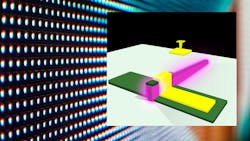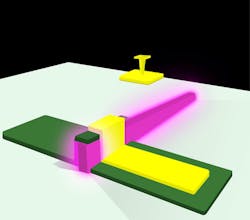A team of researchers from the National Institute of Science and Technology (NIST) the University of Maryland, Rensselaer Polytechnic Institute and the IBM Thomas J. Watson Research Center set out to create a light-emitting diode (LED) for use in small applications, such as the lab-on-a-chip technology scientists at NIST and elsewhere are pursuing.
Instead, they came up with a solution to the problem of efficiency droop in LEDs. It seems LEDs have had a limitation that has been frustrating designers for a long time. Feeding an LED more electricity makes it shine more brightly, but soon the brightness drops off, making the LED highly inefficient. That drop-off is called (you guessed it) the efficiency droop. It prevents LEDs from being useful in several promising applications, from communications technology to killing viruses.
“It’s a new architecture for making LEDs,” said NIST’s Babak Nikoobakht, who conceived the new design. “We use the same materials as in conventional LEDs. But ours uses a different shape.”
“We saw an opportunity in fins, as I thought their elongated shape and large side facets might be able to receive more electrical current,” Nikoobakht says. “At first we just wanted to measure how much the new design could take. We started increasing the current and figured we’d drive it until it burned out, but it just kept getting brighter.”
The device showed an increase in brightness or power of 100 to 1,000 times over conventional tiny, submicron-sized LEDs and emitted wavelengths straddling the border between violet and ultraviolet.
Nikoobakht characterizes the result as a significant fundamental discovery. “A typical LED of less than a square micrometer in area shines with about 22 nanowatts of power, but this one can produce up to 20 microwatts,” he explains. “It suggests the design can overcome efficiency droop in LEDs for making brighter light sources.”
“It’s one of the most efficient solutions I have seen,” said Grigory Simin, an electrical engineering professor at the University of South Carolina who was not involved in the project. “The community has been working for years to improve LED efficiency, and other approaches often have technical issues when applied to submicrometer wavelength LEDs. This approach does the job well.”
The team made another surprising discovery when it was increasing the current. The LED emitted a range of wavelengths at first, but its emissions eventually narrowed to two wavelengths of intense violet. The explanation grew clear: The researchers’ tiny LED had become a tiny laser.
“Converting an LED into a laser takes a lot of effort. It usually requires coupling a LED to a resonance cavity that lets the light bounce around to make a laser,” Nikoobakht explains. “It appears that the fin design does the whole job on its own, without needing to add another cavity.”
A tiny laser would be critical for chip-scale applications not only for chemical sensing, but also in next-generation hand-held communications, high-definition displays and even disinfection.

